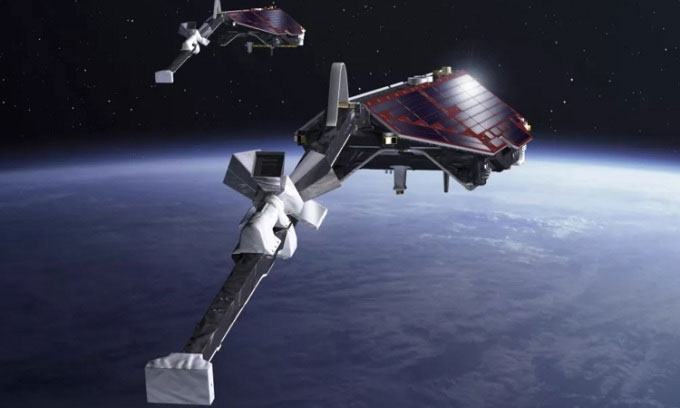Experts are concerned that the new solar cycle will cause satellites in low Earth orbit to deplete their fuel more quickly and re-enter the atmosphere at an accelerated rate.
At the end of 2021, operators of the Swarm satellite cluster from the European Space Agency (ESA) discovered a troubling trend. The satellites designed to measure the Earth’s magnetic field began descending into the atmosphere at an unusually fast rate, ten times faster than before. This change coincided with the onset of the new solar cycle. Experts believe this could mark the beginning of a challenging period for spacecraft orbiting Earth.

ESA must raise the orbit of the Swarm satellite cluster to cope with space weather. (Photo: ESA)
“For the past 5-6 years, satellites have been descending about 2.5 km per year,” said Anja Stromme, the Swarm mission manager at ESA. “But since December of last year, they have been plummeting very quickly. The descent rate from December 2021 to April 2022 was 20 km per year.”
Satellites in low Earth orbit constantly face atmospheric drag, which slows them down and ultimately leads to their re-entry into Earth’s atmosphere. Most spacecraft cannot survive the re-entry process and burn up in the atmosphere. This drag also forces operators of the International Space Station (ISS) to perform altitude-raising maneuvers to maintain the station’s orbit at an altitude of 400 km.
Atmospheric drag also helps to clear space debris in the near-Earth environment. Scientists know that the strength of this drag depends on solar activity. The solar wind emitted from the sun varies in a roughly 11-year cycle. The most recent cycle ended in December 2019 and was relatively quiet, with a lower-than-average number of sunspots and a period of almost no activity.
However, since last autumn, the sun has begun to awaken, emitting increasing amounts of solar wind and forming sunspots, flares, and coronal mass ejections at an accelerating rate. The thermosphere of Earth is also affected.
“There are many complex physical mechanisms that we still do not fully understand occurring in the thermosphere interacting with solar wind. We know this interaction causes the atmosphere to ‘inflate’, meaning denser air is pushed to higher altitudes,” Stromme stated.
Densified air leads to increased drag on satellites. Although the density remains extremely low at 400 km above Earth, changes in the atmosphere are sufficient to pull some low-orbit satellites down.
The Swarm satellite cluster, launched in 2013, consists of three satellites, two of which orbit Earth at an altitude of 430 km, 30 km higher than the ISS. The third Swarm satellite operates at an altitude of 515 km. According to Stromme, the two lower-orbit satellites are more affected by solar activity. The situation for this duo of satellites is so critical that in May 2022, operators had to raise their altitude using onboard propulsion systems.
ESA’s Swarm satellite cluster is not the only spacecraft struggling due to worsening space weather. In February of this year, SpaceX lost 40 new Starlink satellites due to a solar storm shortly after launch. In such storms, satellites often suddenly descend to lower altitudes. The lower the satellite’s orbit, the higher the risk that it cannot return to orbit, leaving operators helpless as they watch them fall through the atmosphere.
Starlink satellites operate at an altitude of 550 km, above the most hazardous area. However, after launch, the Falcon 9 rocket deployed the satellites very low, only about 350 km above the ground. SpaceX then raised the satellites’ orbits using integrated propulsion systems. The company stated that this method has several advantages, such as satellites experiencing technical issues after launch quickly falling back to Earth and not becoming space debris. However, increasing and unpredictable solar activity puts satellites at greater risk.
According to Stromme, all spacecraft flying at around 400 km are facing issues, including the ISS, which must adjust its altitude more frequently to maintain orbit. However, hundreds of small satellites in low orbits with cheap and simple technology are particularly vulnerable. Many new satellites lack propulsion systems, meaning they will have shorter operational lifespans and re-enter the atmosphere sooner.
Solar activity over the past year has been much more intense than experts predicted, with more sunspots, flares, and solar wind directed toward Earth, according to Hugh Lewis, a professor of engineering and physical sciences at the University of Southampton in the UK, who specializes in studying the behavior of satellites in low Earth orbit. In fact, current activity is nearing the forecast for the peak of this solar cycle, and we are still 2 to 3 years away from the maximum phase.
Stromme and her team are raising the orbits of the two satellites by an additional 45 km. The satellite cluster may require more adjustments later this year. Their goal is to extend the mission through the solar cycle.


















































